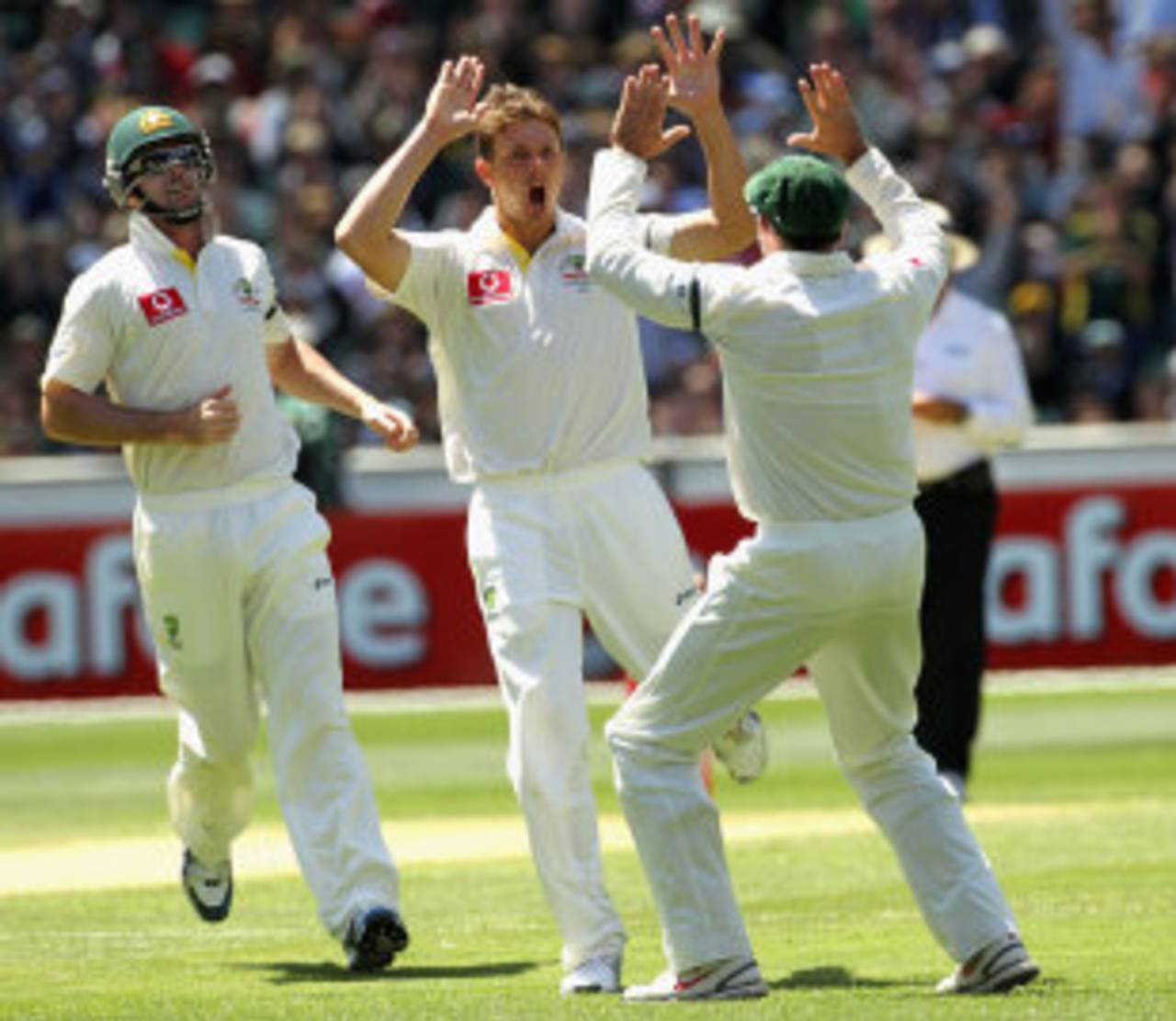In Hobart a fortnight ago, Australia's developing attack bowled to a New Zealand team that collectively hadn't scored 10,000 Test runs. When Sachin Tendulkar walked out to join Rahul Dravid on the second day in Melbourne, the bowlers were faced with 28,302 runs in one pair, the two highest scorers in Test history. At Bellerive Oval, the pitch was as green as
saag. At the MCG, it was as flat as a
roti.
At stumps, the Australians walked off with India's score at 3 for 214. The visitors were unquestionably on top. But Australia could not have been unhappy with the work of their attack, a group that has morphed several times since the tour of Sri Lanka in August. Not since that tour have the bowlers had to work in unhelpful conditions. Here, they toiled hard, and could not be blamed for three missed chances in the field.
The efforts of
James Pattinson were especially impressive. Despite being the youngest and newest member of the bowling group, Pattinson was the most threatening. Consistently, he hurried the batsmen, and he beat them with subtle movement. An hour after the tea break, he sent down a delivery that the speed gun clocked at 153kph. It was an encouraging sign in his third spell.
Against New Zealand, the ball hooped on command for Pattinson in friendly conditions. Here, he needed a back-up plan. When asked last week how he would cope against quality batsmen when the ball was not moving, he said he needed only to look back at the career of Glenn McGrath to see what a fast man should do in such circumstances.
"In the end it all just comes back to building pressure," Pattinson said at the time. "The Indian players like to score runs quickly, so if you build pressure on them and be aggressive, I think that's all you can do. The best bowler in the world, Glenn McGrath, did that for all of his career, he built pressure and he got the rewards for it."
In front of 52,858 of his hometown fans, Pattinson puffed out his chest and steamed in again and again. He did not back down when his follow-through line intersected with the path Virender Sehwag took while running, but nor did he take the tete-a-tete too far.
He could have had Sehwag on 11, when Michael Hussey at gully couldn't hold on to a tough chance. He should have had him on 58, but for Brad Haddin's misjudged dive behind the stumps. The wicketkeeper moved too far to his right and fluffed the catch. So instead, Pattinson bowled Sehwag himself, the ball seaming in just a touch and cannoning off the inside edge onto the stumps.
It was part of a fine spell from Pattinson, who at tea had 1 for 25 from 10 overs. In truth, each of the fast men sent down at least one good, strong spell, and each of them finished the day with one wicket. Pattinson and
Peter Siddle could have had more.
Siddle shook off the frustration of bowling Rahul Dravid off a no-ball and instead shattered the stumps of Sachin Tendulkar. It came in the final over of the day, when he still managed to hit the 150kph mark. On a day when Siddle didn't find much swing or seam, such stamina was all that his captain Michael Clarke could ask for.
Even
Ben Hilfenhaus was in the mid 140kph region late in the day. Hilfenhaus was playing his first Test since being dropped after the Ashes last summer, when his outswing was early, predictable and too easy to leave. Here, his movement was more varied, happened closer to the bat, and his lines were straighter. He picked up the wicket of Gautam Gambhir with the new ball, the batsman uncertain which way the ball was moving.
It remains a concern that Hilfenhaus loses his impact when the shine has worn off the ball. Of Australian bowlers with at least 50 Test wickets, Hilfenhaus has removed the greatest proportion of openers. More than anything, that shows how ineffective he is when the ball stops moving. Again it was the case at the MCG.
Perhaps that was the time the Australians would have used a fifth bowler, had they included one. But they chose the right line-up. Daniel Christian's medium pace would have rested the fast men, but it's hard to imagine him troubling India's powerful batting order. In fact, it is difficult to find a fit fast bowler who would have improved Australia's attack.
Each of the fast bowlers sent down at least as many overs as the offspinner Nathan Lyon, who was neither a success nor a failure. He might have a bigger role to play in the second innings.
Clarke will need to manage the workload of his fast men carefully on the third day, with strong batting still to come and the Sydney Test to start in a week's time. But if they toil like they did on the second day, he will be proud of their efforts.
Brydon Coverdale is an assistant editor at ESPNcricinfo
